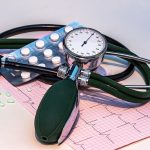What Is The First Drug Of Choice For Atrial Fibrillation?

Atrial fibrillation (AF) is a cardiovascular disorder characterized by an irregular and often rapid heart rate. It occurs when the upper chambers of the heart, known as the atria, experience chaotic electrical signals, causing them to quiver instead of contracting normally. As a result, the atria are unable to pump blood effectively into the lower chambers, known as the ventricles.
AF can be classified into several types, including paroxysmal AF (episodic and self-terminating within seven days), persistent AF (sustained for longer than seven days), long-standing persistent AF (continuous for longer than one year), and permanent AF (accepted and no further attempts to restore normal rhythm).
AF is a common cardiac arrhythmia, and its prevalence increases with age. It is estimated that around 2% of the global population has AF. However, the prevalence varies across different populations and regions. It is more common in individuals over the age of 60, with the risk doubling for each decade after that age. Other risk factors for AF include hypertension, heart disease, diabetes, obesity, sleep apnea, and excessive alcohol consumption.
AF is a significant health concern because it can increase the risk of stroke, heart failure, and other complications.
How does atrial fibrillation affect the heart?
The human heart consists of four chambers: two upper chambers called the atria and two lower chambers called the ventricles.
Every time the heart beats, it pumps blood from the atria into the ventricles and then from the ventricles around the body. Each heartbeat starts at the top of the heart and travels down. Electrical signals control the rate at which the heart beats and coordinate the blood flow between the chambers.
When a person has A-fib, these electrical signals become distorted, causing the atria to quiver, or twitch, erratically. This is called fibrillation. During the heartbeat, the heart may not pump all the blood from the atria to the ventricles, and the blood flow does not follow the usual rhythm.
Many people with an irregular heartbeat, or arrhythmia, do not have any symptoms. However, recognizing and treating A-fib early can significantly improve the likelihood of preventing complications.
Signs and Symptoms of Atrial Fibrillation
Atrial fibrillation (AF) can manifest with various signs and symptoms, although some individuals with AF may not experience any noticeable symptoms at all. Common signs and symptoms of AF include:
1. Palpitations: A rapid, irregular, and sometimes pounding heartbeat is one of the most common symptoms of AF. It may feel like your heart is fluttering, racing, or skipping beats.
2. Fatigue: Many individuals with AF report feeling tired or exhausted, even with minimal physical exertion or at rest. This fatigue can significantly impact daily activities and quality of life.
3. Shortness of breath: Some people with AF may experience breathlessness or difficulty breathing, especially during physical activity or exertion. This symptom may be accompanied by a feeling of tightness in the chest.
4. Dizziness and lightheadedness: AF can cause a sensation of dizziness, lightheadedness, or faintness. This may be due to the irregular heart rate and inadequate blood flow to the brain.
5. Chest pain or discomfort: Chest pain or discomfort is less common in AF but can occur. It is typically described as a tightness, pressure, or squeezing sensation in the chest.
6. Weakness or inability to exercise: AF may result in decreased exercise tolerance and reduced stamina. Activities that were previously manageable may become more challenging.
7. Anxiety or uneasiness: The irregular heartbeat and associated symptoms can lead to feelings of anxiety, nervousness, or a sense of unease.
It’s important to note that the severity and frequency of symptoms can vary among individuals with AF. Some people may experience occasional symptoms during AF episodes, while others may have persistent or chronic symptoms. Additionally, some individuals may only discover they have AF when it is detected during routine medical examinations or tests, such as an electrocardiogram (ECG).
What Is The First Drug Of Choice For Atrial Fibrillation?
The choice of drug for treating atrial fibrillation (AF) depends on several factors, including the type of AF, the presence of other medical conditions, and individual patient characteristics. The treatment goals for AF may include controlling heart rate, restoring and maintaining normal heart rhythm (rhythm control), and preventing blood clots.
In general, the first-line drug of choice for AF is often a medication called a beta-blocker or a calcium channel blocker. These medications help slow down the heart rate and can be effective in controlling the symptoms associated with AF. They work by blocking certain receptors or channels in the heart, thereby reducing the electrical impulses that cause the heart to beat rapidly.
How First Choice Atrial Fibrillation Drug Work
1. Beta-blockers: Beta-blockers are a class of medications that work by blocking the effects of adrenaline (epinephrine) on the heart. By doing so, they slow down the heart rate, reduce the force of the heart’s contractions, and help stabilize the electrical signals in the heart. Beta-blockers commonly used for AF include:
a. Metoprolol (Lopressor, Toprol XL): Metoprolol is a selective beta-1 receptor blocker. It is often used in AF to control heart rate, especially in individuals with underlying heart disease or hypertension.
b. Atenolol (Tenormin): Atenolol is another selective beta-1 receptor blocker. It is used to slow the heart rate and manage AF, particularly in patients with co-existing heart conditions.
c. Propranolol (Inderal): Propranolol is a non-selective beta-blocker that blocks both beta-1 and beta-2 receptors. It can be used to control heart rate in AF and is sometimes preferred for patients with both AF and concurrent conditions like migraines or essential tremors.
2. Calcium channel blockers: Calcium channel blockers inhibit the influx of calcium ions into heart muscle cells, leading to relaxation of the heart and blood vessels. This results in a reduced heart rate and improved control of AF. Calcium channel blockers commonly prescribed for AF include:
a. Diltiazem (Cardizem, Tiazac): Diltiazem is a non-dihydropyridine calcium channel blocker that slows down the heart rate and helps control AF. It is often used when beta-blockers are not well-tolerated or contraindicated.
b. Verapamil (Calan, Verelan): Verapamil is another non-dihydropyridine calcium channel blocker. It is primarily used for rate control in AF, especially in individuals with normal left ventricular function.
These medications are typically started at a low dose and adjusted based on individual response and tolerability. The choice between beta-blockers and calcium channel blockers depends on factors such as patient characteristics, underlying medical conditions, and potential drug interactions.
It’s important to note that the use of antiarrhythmic drugs or other medications may be considered for rhythm control in certain cases of AF. Additionally, anticoagulant therapy, such as with medications like warfarin or direct oral anticoagulants (DOACs), may be prescribed to reduce the risk of blood clots and stroke associated with AF, especially in patients with additional risk factors.
Ultimately, the selection of the first-line drug for AF will be determined by the healthcare professional after evaluating the patient’s specific clinical situation, medical history, and any existing comorbidities.
Side Effects Of Medications Used To Treat Atrial Fibrillation
The medications used to treat atrial fibrillation (AF) can have potential side effects, although not all individuals will experience them. It’s important to note that the specific side effects and their severity can vary depending on the medication used and individual patient factors. Here are some potential side effects associated with the commonly used drugs for AF:
1. Beta-blockers:
• Fatigue or tiredness
• Dizziness or lightheadedness
• Cold hands and feet
• Slow heart rate (bradycardia)
• Low blood pressure
• Erectile dysfunction or decreased libido
• Depression or mood changes
• Difficulty sleeping (insomnia)
• Shortness of breath or wheezing (less common)
2. Calcium channel blockers:
• Flushing or feeling warm
• Headache
• Dizziness or lightheadedness
• Swelling in the ankles or feet
• Constipation or nausea
• Low blood pressure
• Slow heart rate (bradycardia)
• Fatigue or tiredness
• Shortness of breath (less common)
3. Antiarrhythmic drugs (e.g., amiodarone, flecainide):
• Nausea or upset stomach
• Dizziness or lightheadedness
• Fatigue or tiredness
• Vision changes or sensitivity to light (with amiodarone)
• Lung problems (rare but potentially serious, with amiodarone)
• Liver problems (rare but potentially serious, with amiodarone)
4. Anticoagulant medications (e.g., warfarin, DOACs):
• Increased bleeding risk
• Bruising or bleeding easily
• Gastrointestinal bleeding (stomach or intestinal bleeding)
• Blood in urine or stools
• Nosebleeds
• Menstrual bleeding changes
• Back pain or bloody urine (less common, with warfarin)
It’s important to discuss potential side effects with your healthcare professional before starting any medication for AF. They can provide detailed information about the specific drug being prescribed, its potential side effects, and how to manage them. It’s also essential to promptly report any concerning or severe side effects to your healthcare provider.
Remember that the benefits of medication in treating AF, such as reducing symptoms or preventing complications, are generally considered to outweigh the potential risks of side effects. Your healthcare professional will carefully evaluate the benefits and risks of each medication and tailor the treatment plan to your individual needs and circumstances.
What is the latest treatment for atrial fibrillation?
Several advancements have been made in the treatment of atrial fibrillation some recent advancements that have been shaping the management of the condition include:
1. Catheter Ablation: Catheter ablation is a minimally invasive procedure that aims to restore normal heart rhythm by selectively destroying or isolating the areas in the heart that trigger or sustain AF. This technique has evolved over the years with the introduction of advanced mapping technologies, such as high-density mapping and contact force sensing, which enhance the precision and success rates of the procedure.
2. Hybrid Procedures: Hybrid procedures involve a combination of surgical and catheter-based techniques. In certain cases, surgical ablation is performed in conjunction with catheter ablation to target both epicardial (outer layer of the heart) and endocardial (inner layer of the heart) sources of AF. These hybrid approaches have shown promise in achieving better outcomes, especially in patients with more complex forms of AF.
3. Left Atrial Appendage Closure (LAAC): The left atrial appendage (LAA) is a small pouch in the heart where blood clots can form in individuals with AF, increasing the risk of stroke. LAAC procedures involve sealing off the LAA to prevent blood clots from forming and reduce the need for long-term anticoagulant therapy. Devices like the Watchman™ and Amplatzer™ Amulet have been approved for use in LAAC procedures.
4. Novel Oral Anticoagulants (NOACs): While NOACs were introduced several years ago, they continue to play a significant role in the prevention of stroke and systemic embolism in patients with AF. Unlike warfarin, NOACs have a more predictable anticoagulant effect, do not require frequent monitoring, and have shown comparable or superior efficacy and safety outcomes in clinical trials.
5. Digital Health Technologies: The integration of digital health technologies, such as wearable devices and mobile applications, has facilitated remote monitoring and management of AF. These tools allow patients to track their heart rhythm, symptoms, and medication adherence, while also enabling healthcare providers to remotely monitor patient data and adjust treatment plans accordingly.
It’s important to note that advancements in the field of AF treatment continue to emerge. The most up-to-date information regarding the latest treatment options and developments can be obtained from healthcare professionals who specialize in cardiac arrhythmias and have access to the most current research and guidelines.





